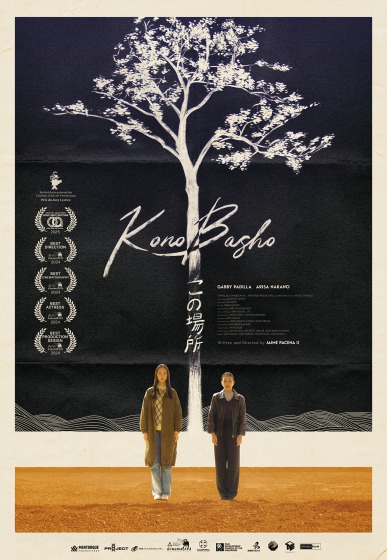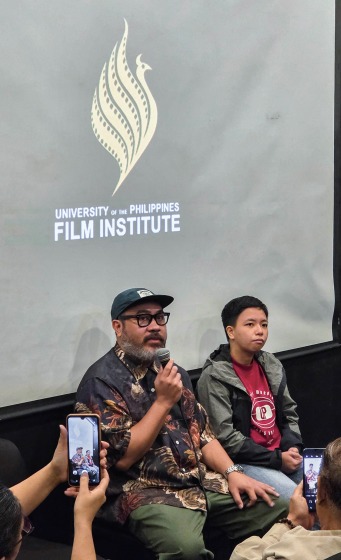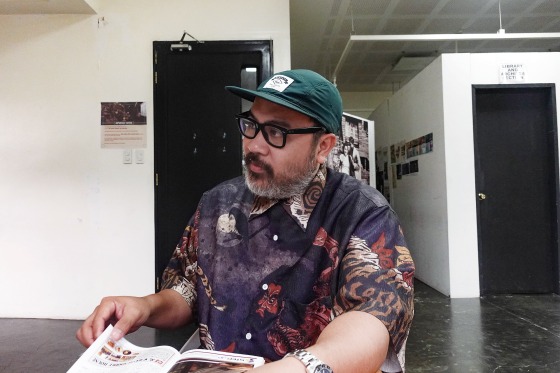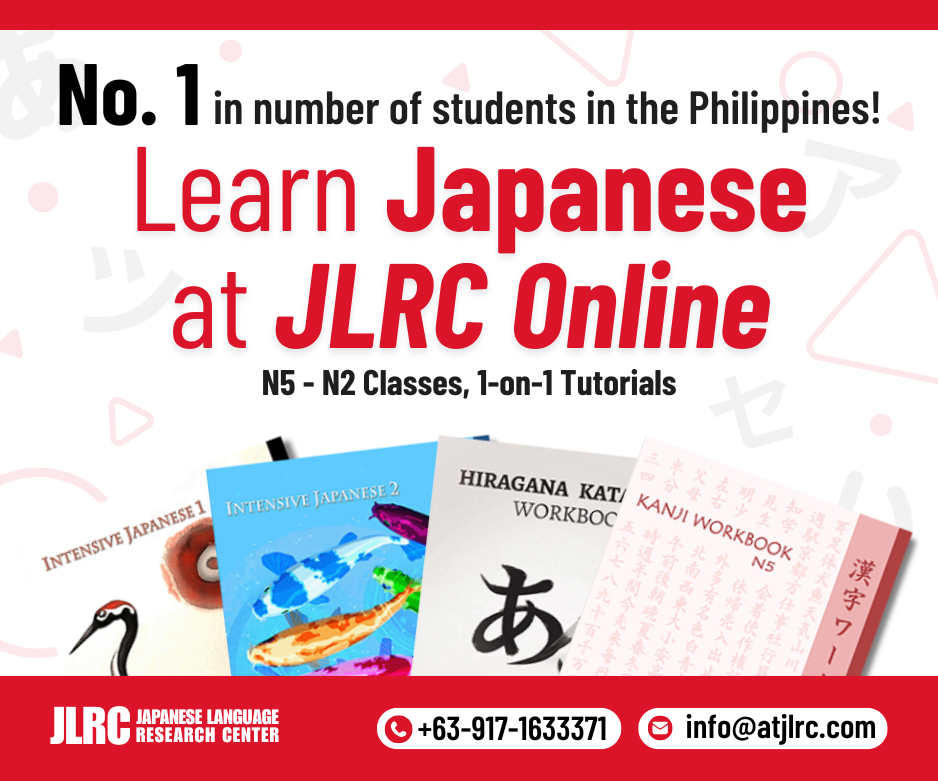悲しみは寄せる波のように、常にある。
決して消せない現実の中で、力強く生きる人々を描きたかった

ハイメ・パセナさん
ビジュアル・アーティスト。マニラ首都圏ケソン市出身。サントトマス大学卒業。
クリエイティブ・アーティストグループ「ブリス・マーケット・ラボラトリー」創設者・クリエイティブ・ディレクター。子どもたちにフィリピンの芸術、文化、環境への理解を支援するNGO団体「キャンバス」キュレーターを務め、アジア・パシフィック・カレッジでマルチメディア、映画制作の教鞭を執る。広告やミュージックビデオを手がける一方、長編映画『この場所』を初監督。同作品は映画祭「シネマラヤ2024」で最優秀監督賞、最優秀女優賞、最優秀撮影賞を受賞した。3月には大阪アジアン映画祭で上映され、6月には陸前高田、7月には東京で公開予定。
Jaime Pacena Ⅱ
Mr. Pacena is an Advertising Arts graduate from the University of Santo Tomas
and has since expanded his practices beyond his education.
He is currently a Visual Artist with several personal projects, a Curator
for CANVAS.PH, the Founder and Creative Director of Bliss Market Laboratory,
a Professor for Multimedia Arts students, and a Film Director.
His journey as a director began with advertisements and music videos,
eventually leading to his first full-length film, “Kono Basho” in
Cinemalaya 2024, starring Gabby Padilla and Arisa Nakano.
The film won Best Director, Best Actress, Best Cinematography,
and Best Production Design.
フィリピン人監督が日本を舞台に撮った映画のおそらく最新作にして一番の話題作といえば、『この場所』ではないでしょうか。被災した岩手県陸前高田市を舞台に、人々の「悲しみ」に焦点を当てた本作品は、昨年フィリピンのインディペンデント映画祭「シネマラヤ2024」で数々の賞に輝きました。この映画で長編映画の初監督デビューを飾ったハイメ・パセナ監督に陸前高田を舞台に選んだ理由や、映画に込めた思いを聞きました。
被災した陸前高田市に
自分の人生経験を投影
初めて日本に長期滞在したのは2010年6月から9月、国際交流基金のプログラムで国際芸術センターのレジデント・キュレーターとして活動した青森県でした。そのときに仙台、東京、箱根、京都、名古屋、広島、高松、直島などへも訪れる機会がありました。そして、翌年3月に東日本大震災が起き、その5カ月後に宮城を訪れました。いったい何が起きたのかを理解し、その状況下でアートができることは何かを考えたんです。
岩手県の陸前高田市を訪れたのは、2013年の冬。レジデント・アーティストとして滞在したのですが、津波の影響で宿泊場所はなく、自動車教習所の寮にほかのアーティストたちと泊まりました。インターネットもなかったので、バスの待合室でWiFiをつなげて作業しました。
私が取り組んだのは仮設住宅で暮らす被災者を訪ね、津波によって住むところを失った人たちの話を聞くこと。そして、海の近くに住んでいた人は、もう元の場所には戻れないこと、震災後の一時的と思われた避難に終わりは見えず、かつて住んでいた場所を永久的に離れることを余儀なくされていると知ったのです。しかし、悲しみに沈んでばかりいるのではなく、人々は復興をめざしていた。日本のほかの場所で会った人たちよりも、ずっと強い意志を感じられました。陸前高田を舞台に映画を撮ろうと決めたのは、そうした人々の姿が印象的だったこと、美しく静謐(せいひつ)な環境があること、そして何よりも自分の個人的な経験に通じるものを思い起こさせてくれたからです。復興をめざす人々の姿は、私の人生に指針を与えてくれました。地元の人たちにとって陸前高田とは、単なる場所ではなく、それ以上の意味を持つものだと感じました。
映画のタイトル『この場所』を英語で直訳するとThis Place。英語で立ち退かせるという意味のDisplaceと発音が似ています。映画に出てくるのはまさにDisplaceされた人たち。『この場所』というタイトルにはこのような意味も込めています。

Official Poster from Project8Projects and Mentorque Productions
映画に込めたアンチテーゼと
決して消し去れない現実
2013年以降、陸前高田には14年、 16年、19年、22年、23年に訪れ、映画の脚本執筆と撮影に取り組みました。日本の習慣や文化を描くにあたっては正確であることを期す一方、メディアによって喧伝(けんでん)されてきた貧しくかわいそうな典型的なフィリピン人像に反論の気持ちを込めて、『この場所』には社会的に成功しているフィリピン人を登場させました。
私が映画を通じて伝えたかったこと、それは被災し、復興をめざす人々にとって、悲しみは消えることなく常にともにある、ということです。その悲しみは、波のようなものです。私たちが人生において経験する悲しみは、波のように寄せては返す。その波が穏やかなときは、前に進むことができる。しかし、完全に消し去ってしまうことはできないのです。
『この場所』を見た人から、是枝裕和監督の作品のようだと言われました。うれしかったですね。光栄です。是枝監督の作品はほとんど見ていますし、日本の日常生活を描くにあたって、影響を受けています。ほかにも好きな映画を挙げるなら、『Tumandok』(2024年/リチャード・サルバティコ、アーリー・スイート・スマガイサイ 監督)、「An Errand」(2024年/ドミニク・ベカールト 監督)『Iti Mapukpukaw(The Missing)』(2023年/カール・ジョセフ・パパ監督)、『Oro, Plata, Mata』(1982年/ペケ・ガラパ監督)など。特にジャンルにはこだわりません。どんなことを感じさせてくれる映画なのかということが、私にとっては大事。言いたいこと、伝えたいことを持っている作品が好きですね。
日本でまた映画を撮ってみたいと思いますが、しばらくはフィリピンに焦点を合わせ、集中したい。そして、いつか家族をテーマにした映画を撮りたいと思っています。人は誰でも家族と関わりを持っていて、家族には特別な思いを持っていると思うので。

3月、フィリピン大学ディリマン校フィルム・インスティチュートでの上映後、観客からの質問に答えるパセナ監督。 Director Pacena answers questions from the audiences at the screening event in the UP Film Institutethe in March.
Comfort, Healing, and Grief:
An Understanding that Transcends Cultures
March 11, 2011, marked one of Japan’s most devastating natural disasters. The widespread tsunami and earthquake caused thousands to pass away and destroyed cities. Though time has passed and wounds have healed, the scars of the past will always be present, along with the grief one feels. Set in Rikuzentakata City, Kono Basho tells a heartwarming story parallel to this tragedy where waves symbolize our experiences in life—that despite destruction, moving forward may be difficult but never impossible.
Familiarity in an Unknown Place
Of all the cities Mr. Pacena has visited in Japan, Rikuzentakata is close to his heart because of his personal experiences there. He felt a connection with the people and was inspired by their perseverance and motivation to keep going. Although he was not a victim of the tsunami in a literal sense, he related to them through the events in his own life.
The first Rikuzentakata Artist-in-Residence Program in 2013 was his initial encounter with the city. They were told to learn about the victims, observe how they were coping after the tsunami, and find inspiration in how art can help the situation. He documented the people and the surroundings through photography, and some of them were even shown in Kono Basho.
For him, Rikuzentakata, along with other cities, is more than just a physical space; it is a place comprised of the different stories and experiences of the people, ultimately giving it beauty and meaning.
Displacement from Life
During the early stages of Kono Basho, Mr. Pacena simply wanted to write a story about his life and was reminded of his time in Rikuzentakata. As the plot developed, he accepted changes and it eventually evolved into the film we know now. When it came to the traditions and customs, he made an effort to study the culture so that he could write the script with authenticity and accuracy. He verified his work with people as much as he could and realized that seeing the victims navigate their lives after the tsunami also helped him navigate his own. The title “Kono Basho” is literally translated as “This Place,” which is a play on words for “Displaced.”
Being an artist in residence in Rikuzentakata more than once allowed Mr. Pacena to witness how the city developed after the tsunami and helped him understand the concept of displacement better. With many homes turned into rubble, people were displaced multiple times from one temporary residence to another. Although circumstances improved and things started to become more permanent, it can be difficult to let go of the past, especially if it disappeared in the blink of an eye. They were not just displaced from their homes but also from where they stood in life.

A Message of Hopee
“Waves will always be there” is a beautiful message Mr. Pacena wanted to convey through his film; that when the waves are too strong, take a step back, and when they’re calmer, move forward. He shares with us the importance of understanding and accepting the experiences we have when it comes to loss because just like the waves, grief remains, and as it flows, so does life.
One of the stories that Mr. Pacena shared with us was about his friend who owns a construction company in Rikuzentakata City. He told us that after the tsunami hit, his friend worked non-stop to help the people and reconstruct the city. At around 2023-2024, there was nothing left to build or fix. His friend was able to sit down and rest, and suddenly, all the grief he had but couldn’t feel washed over him.
Kono Basho gives comfort and hope that no matter how far the waves wash us away, they always lead us back to the shore. The loneliness we feel when something is lost can be overwhelming but there will always be someone who is with us no matter what. When it came to the two sisters in Kono Basho, their bond was inevitable despite the difference in cultures and the barrier in language because true understanding comes from empathy.Though their grief may have had different causes, grief itself is all the same.
The Next Steps
Having many plans for the future, Mr. Pacena would like to continue his path to center his work on family because it is one of the strongest bonds a person can have. It is deeply connected to our emotions and it is close to his heart and his values. He is currently working on an 8-episode series set in Metro Manila that also touches on the concept of displacement and is inspired by his own home. One of his plans includes another film related to Japan but he would like to focus on the Philippines for the time being.
The completion of Kono Basho goes to show that film can be a universal language that goes beyond barriers where we can learn about each other while reflecting on ourselves.
Text & Photo: Monica Alquiro
















